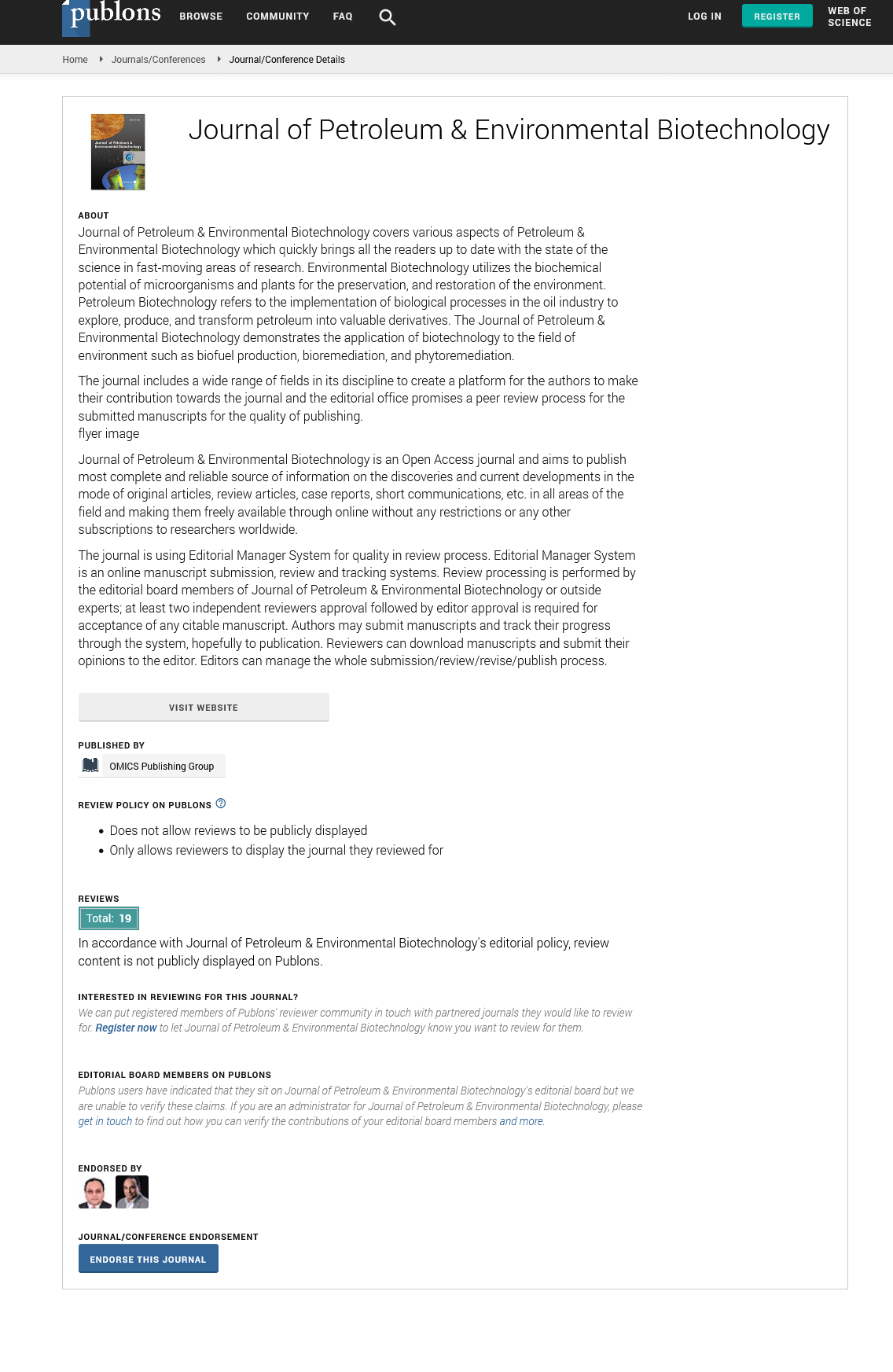Indexed In
- Open J Gate
- Genamics JournalSeek
- JournalTOCs
- China National Knowledge Infrastructure (CNKI)
- Electronic Journals Library
- RefSeek
- Hamdard University
- EBSCO A-Z
- OCLC- WorldCat
- SWB online catalog
- Virtual Library of Biology (vifabio)
- Publons
- MIAR
- Euro Pub
- Google Scholar
Useful Links
Share This Page
Journal Flyer

Open Access Journals
- Agri and Aquaculture
- Biochemistry
- Bioinformatics & Systems Biology
- Business & Management
- Chemistry
- Clinical Sciences
- Engineering
- Food & Nutrition
- General Science
- Genetics & Molecular Biology
- Immunology & Microbiology
- Medical Sciences
- Neuroscience & Psychology
- Nursing & Health Care
- Pharmaceutical Sciences
Perspective - (2024) Volume 15, Issue 4
Restoring Vital Resources of Soil and Groundwater Contamination Management and Remediation
Olivia Chloe*Received: 25-Nov-2024, Manuscript No. JPEB-24-27947; Editor assigned: 29-Nov-2024, Pre QC No. JPEB-24-27947 (PQ); Reviewed: 13-Dec-2024, QC No. JPEB-24-27947; Revised: 20-Dec-2024, Manuscript No. JPEB-24-27947 (R); Published: 27-Dec-2024, DOI: 10.35248/2157-7463.24.15.589
Description
Soil and groundwater contamination, primarily caused by industrial activities, urbanization and agricultural practices, represents a significant environmental challenge globally. These pollutants, ranging from heavy metals to organic solvents, pose substantial risks to ecosystems and human health. Remediation strategies, including physical, chemical and biological methods, have evolved over the years to address these contaminants. This article provides an overview of the current state of soil and groundwater remediation technologies explores their advantages and limitations and discusses emerging trends in this field. Additionally, it highlights the importance of integrating environmental policies and technologies for effective long-term remediation solutions.
Soil and groundwater are two essential components of the Earth’s ecosystem, providing essential services to support life. Soil serves as a medium for plant growth, nutrient cycling and carbon sequestration, while groundwater supplies potable water for drinking and irrigation. However, with increasing industrialization, urban sprawl and agricultural intensification, both soil and groundwater have become vulnerable to contamination. Pollutants such as heavy metals, pesticides, solvents and industrial waste can severely degrade these vital resources, affecting biodiversity, human health and the overall quality of life. Soil and groundwater remediation refers to the processes used to remove or neutralize contaminants from these mediums. While the ultimate goal is to restore the natural state of these resources, remediation techniques are selected based on several factors, including the type of contaminant, environmental conditions and the scale of contamination.
Soil contamination occurs when harmful substances such as heavy metals (lead, mercury, cadmium), organic pollutants (pesticides, solvents), or radioactive materials enter the soil. This contamination primarily stems from industrial discharges, agricultural runoff and improper disposal of hazardous waste and fuel leaks. The persistence of many of these contaminants in the soil, often due to their low biodegradability, can result in long-term pollution.
Groundwater contamination often occurs as a result of the percolation of pollutants through the soil, reaching aquifers that supply drinking water. Common contaminants in groundwater include petroleum products, heavy metals, pesticides and industrial solvents. Groundwater pollution is of particular concern because it is difficult to detect, often remaining unnoticed until water supplies are significantly impacted. Physical methods of soil remediation involve the removal of contaminated soil or the separation of pollutants from the soil matrix. Techniques such as soil excavation and off-site disposal, thermal desorption and soil washing are commonly used for certain types of contamination.
In this method, contaminated soil is physically removed from the contaminated site and transported to a landfill or treatment facility. This technique is effective for highly contaminated sites but can be costly and disruptive to the environment. This method uses heat to volatilize contaminants, which are then captured and treated. It is particularly effective for organic pollutants, such as solvents and oils. Involves the use of water, surfactants, or solvents to wash contaminants from the soil. This method is often used for soils contaminated with metals, petroleum products and other inorganic pollutants. Chemical remediation techniques use chemical reactions to transform contaminants into less harmful or non-toxic substances. Methods like chemical oxidation and reduction, phytoremediation, and in situ stabilization are widely employed in soil treatment.
This technique involves adding oxidizing or reducing agents to the contaminated soil to break down hazardous compounds. Potassium permanganate and hydrogen peroxide are commonly used oxidants. Certain plant species can absorb heavy metals or organic pollutants through their roots, which are then stored or degraded within the plant tissues. This process involves adding chemicals to the contaminated site to immobilize contaminants, preventing their movement and reducing bioavailability.
Bioremediation is a process that utilizes microorganisms to degrade or detoxify pollutants in soil. This natural process can be enhanced through the addition of nutrients, oxygen, or other conditions that promote microbial activity. Bioremediation is particularly effective for organic contaminants, such as petroleum products, solvents and pesticides.
This approach involves stimulating the microbial population directly within the contaminated soil. It is cost-effective, but the success of this method depends on factors such as soil temperature, moisture content and the type of contaminants. In this method, contaminated soil is excavated, treated in bioreactors or other controlled environments and then returned to the site once cleaned. This technique is faster than in situ methods but may be more expensive. Groundwater contamination is often more challenging to remediate due to its depth and mobility. The primary goal of groundwater remediation is to remove or neutralize the contaminants present in the aquifer or groundwater supply. This traditional method involves pumping contaminated groundwater to the surface, where it is treated before being reinjected into the aquifer or disposed of properly. The treatment process may include filtration, chemical treatment, or aeration, depending on the type of contamination.
Citation: Chloe O (2024). Restoring Vital Resources of Soil and Groundwater Contamination Management and Remediation. J Pet Environ Biotechnol. 15:589.
Copyright: © 2024 Chloe O. This is an open-access article distributed under the terms of the Creative Commons Attribution License, which permits unrestricted use, distribution, and reproduction in any medium, provided the original author and source are credited.

